Hello all ![]()
I removed the drawing because it was faulty and incomplete. Soon I will post the correct one. Sorry for the confusion
Edit from Chris:
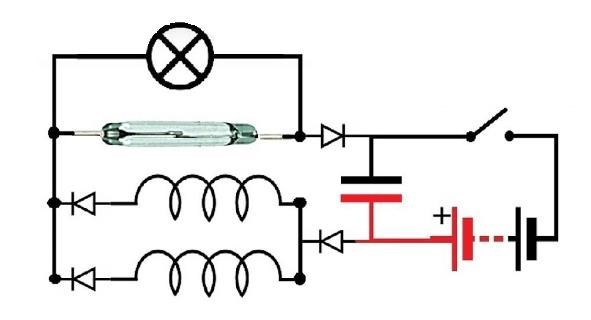
Hello all ![]()
I removed the drawing because it was faulty and incomplete. Soon I will post the correct one. Sorry for the confusion
Edit from Chris:




Nice to see this here L0stf0x! ![]() I will replicate it and share my results with you and every one here!
I will replicate it and share my results with you and every one here!
I am much than happy to have a builder like you here!
Sincerly!
here is the video to make a simple relay to latching relay ![]()
For those researching these systems. As best I could determine this concept works. The challenge here would be that you need 4x the number of batteries and a stable battery chemistry. Switching for a system like this can be achieved using 4 relay modules, and the system would generally be switched when ether the charge battery voltage gets too high or the run voltage too low.
I decided not to go this route myself, even though there were promising results. The best path to making it useful seem to be to develop a stable chemistry designed to work in this configuration long term. Most commercial batteries are not designed for deep discharge and many discharge cycles. Also they may require a certain voltage range for optimal recharging that unregulated pulses may exceed (what undesirable chemical reactions can result from this I can only imagine). Nothing really insurmountable. Hopefully others will be inspired to look deeper here.
Awesome work L9stf0x!!! Thank you for sharing!
Wistiti and I have a formula for calculating the Batteries Energy.
A series connection adds the voltage of the two batteries, but it keeps the same amperage rating (also known as Amp Hours). For example, these two 1.5-volt batteries joined in series now produce 3 volts, but they still have a total capacity of 1.9 amps.
Energy is Joules, Watts is Joules per-second. The Energy can be calculated here by using the simple formula:
E = C x Vaverage
Where:
E = Energy in Joules
C = Capacity in amp-hours
V = Average Voltage
EStart = 2.506 * 1.9 * 3600Seconds = 17141.04 Joules
EEnd = 2.406 * 1.9 * 3600Seconds = 16457.04 Joules
ETotal = EStart - EEnd = 17141.04 - 16457.04 = 684 Joules------------------------------------------------------------------------
EStart = 12.30 * 7.2 * 3600Seconds = 318816 Joules
EEnd = 12.43 * 7.2 * 3600Seconds = 322185.6 Joules
ETotal = EStart - EEnd = 318816 - 322185.6 = -3369.6 Joules
ECOP = EOut / EIn = 3369.6 Joules / 684 Joules = 4.93 X more Energy Delivered to the Charge Battery than was used from the Source Battery:
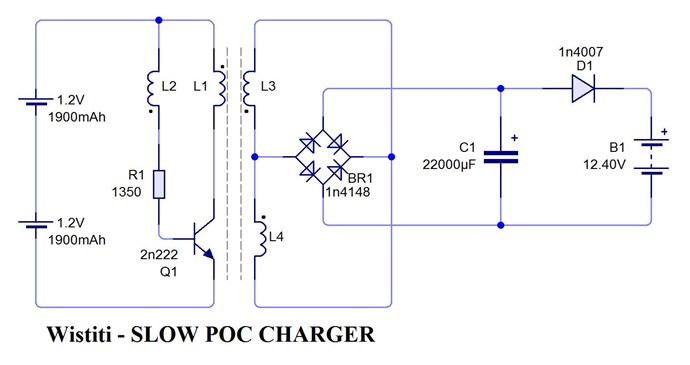
Like you, Wistiti did get some good results! Using smart combinations and ensuring Energy is "Generated" for at least part of the Cycle.
For those studding, please take very special note of Wistiti's Coil Configurations, Approximate 1/4 Wave length is used.
Best Wishes
Chris
Hahaha! don't worry Chris, L0stf0x know what he is doing! ![]() He is the kind of builder who have the attitude it need to have success!
He is the kind of builder who have the attitude it need to have success! ![]()
It will be another great builders team journey!
Like you my friend, I hope some other builders will manifest and join in the POC adventure!
Apologies my friend, I know, only trying to be helpful. Yes, my post was more so for others interested.
Chris
Hey! No problem my friend! You always be helpful!
Take care!
The last best connection I find for the load...
ps: I also use a dcdc converter...
Hey L0stf0x - This is excellent! Very productive, big steps forward!
They are Big Reed Switches! Nice price too! Put Ad's on your Videos, I will give you some sponsorship! Soon pay for them!
Thanks for sharing.
Chris
Hey L0stf0x - This is excellent! Very productive, big steps forward!
They are Big Reed Switches! Nice price too! Put Ad's on your Videos, I will give you some sponsorship! Soon pay for them!
Thanks for sharing.
Chris
You are welcome Chris
My videos are very bad for the regular people
My videos are made only for forum purposes, to see them people who will understand
The common person will think what the f... is this? And he will be right
After all they aren't so popular to bother
But thanks for the advice

Mechanical failures can be very frustrating, I'd recommend including a fuse.
The nice thing about the reed switch in this circuit is that it can act as a dynamic spark gap. As the contacts move away the gap distance increases. I am not sure how much capacitance of the contacts plays a role, but that also should change. I wonder how important this is. Also the choice to use bucking coils is interesting, but I know this works with just a normal coil, so I wonder how important the bucking coil is.
For any physical phenomena that exists there is a set of conditions needed to manifest that phenomena. It stands to reason that any device which re-creates these conditions should produce the phenomena. The difficulty is in knowing what is going on, whats important and what's not important. I don't have the answers here, but I am glad you shared this, its very interesting.
Here is another replication by George Haniotakis..
Zanzal you are right, Its working with simple coil but not that good, I already try it.
The magnet just ads Bias to the reed only, It does not affect the coil, only the reed. Actually the magnet is not wanted near the coils.
Next test in list is to try to apply the current amplifier technique on the same circuit.. But first the reed has to be stabilized in a comfortable frequency with caps.. Then I have to tune with caps again the bucking coils to be in resonance with the frequency of primary (reed). Then we ll see ![]()
Question: Has anyone tried the bucking coils with multi strand wire, but the strands connected as biffilar type (each coil)?
Hi LostFox!
Nice to see goerge replicate your device and show this great results! ![]()
For your question regards the multistrands wire, i have not yet try it bucking or the way you say but i have try it in the past with 3 // strands in the plasma generator (like what George have share when he try the looping) and it give me better results than the same with just one wire...
https://m.
...so maybe the way you propose is a much better way to go...!? We know how to have the answer... Thanks for sharing and be here with us my freind!![]() Building!!
Building!! ![]()
The magnet just ads Bias to the reed only, It does not affect the coil, only the reed. Actually the magnet is not wanted near the coils.
Perhaps..It would be very interesting if the magnet could be removed to understand how much influence the permanent magnetic field has, but I guess it doesn't really matter. Anyway, this looks really awesome, I am hoping to do a replication soon of it. I'll probably toss it into an Akula type arrangement just to see how well it performs. Thanks so much for sharing it, I'm eagerly awaiting your corrected schematic to see how you've improved upon this.
Hello and welcome MrBlobby!
You're right, there is a set of Key Principles, however the geometries can vary greatly from device to device.
If you follow the links above and study on the links here and on my website: www.hyiq.org - We have laid out lots of data.
Electrical Energy is very beneficial to study, as the greats before us also found. See our Support Section for a small snippet of this information.
Chris
I've gotten some good information from Rick Friedrich's youtube channel. Rick did a good video on the use of Zinc sheeting for EM shielding. Wish I could find it. Might be really useful actually for a device like the Plasma Generator. He's also pointed out that a gentleman named Benitez described the "splitting the positives" (which Rick refers too as "loving paths"), so it shows others have been aware of these things for a long time.
Hi MrBlobby, some come fresh, new, to this field, not knowing some of the most important things about Electromagnetic Induction, in point of fact I know Electrical Engineers of 30+ years that have not the slightest understanding of Electromagnetic Induction, so please excuse my introduction if you are already learned in the field.
If you have a link, please post, I have not seen or heard of this video until now. Ctrl + C pastes the link into the text field.
I think we, all of us together are doing a great job, its great to hear about the progress of others. To me, it seems as if more people are working toward one end goal now, instead of many.
L0stf0x and Wistiti are doing excellent work! We have right here very interesting tech!
Chris
Wistiti - Fantastic Work my friend! Another excellent example of how Electrical Energy is "Generated" using Coils and Opposing Magnetic Fields from Partnered Output Coils!
Simple, cheap and very smart way to move forward with Energy Machines!
Fantastic Work!
Chris
Hey Wistiti,
That looks awesome. Did you say there two sets of POCs on that? Like 4 coils total or just the two coils in the bucking arrangement?
What kind of lifetime are you seeing on your reed switches? That would be my primary concern with practical use, having to replace reed switches.
agree reed switch give a really sharp pulse to the device but have the wrong side to be with a defenite life spawn and are also tricky to adjust...
Our freind last experiment. ![]()



@L0stf0x,
Excellent work!
Come back here, to this forum, it would be great to have you back, here as part of our team!
Chris




Hi Fox !!. i appreciate your youtube channel. and the anet A8. great tool. i purchased 2 of them !
Hello L0stf0x,
I saw these type of experiments before and I think they are very interesting. Some variants of joule thiefs can do similar things.
Regarding below video I have 2 questions.
- On the right side we see 2 x 18650 Li-Ion batteries in series sitting on 9.34 V. How is this possible?
Li-Ion's are 4,2 V max . x 2 = 8,4V max.
- In case they were over charged they should be damaged or dead. How can these batteries still take a
charge ??



Hey GR , There are two different types of Li-ion batteries, with rated voltage 3.2v and the other 3.6v, the latter can support voltage up to nearly 5 v without being damaged. Vidura
Hi Vidura,
Correct, but these ones are rated nominal 3,6V and max 4,2V.
L0stf0x already replied to me on YT. The batteries were over charged and clearly faulty.
Still weird though. I have over a thousand 18650 batteries and experimented a lot with them. Also with high voltage spikes from Bedini circuts, SEC exciters and all sorts joule thief variants. I never managed to get them over charged 1 volt above max.
Hello my good friends Chris and Wistiti and all!! I am sorry to be away from the forum for nearly two years.!.. Its difficult for me to follow the discussions and participate, while I was working full time on something very different. So I had to be away, concentrate to my build to finish it, and get back with something good.
Those last videos was taken before 2 years. I had them in private mode just for my friends to see, and I made them public before 2 days without any specific reason. ![]()
Getreal you are right, Those batteries probably had chemical mutation due to improper current/voltage form that was being used to feed them. They have been left for days and days charging this way. But I agree with you, its weird.
I remember I had also made an automatic battery switcher using comparator and latching relays, and the load can be a motor-generator coupling or an isolation (POC) transformer to feed the giving batteries back with energy and provide energy also for some load. The trick is to minimise heat losses. The bad thing about split positive was the batteries and their sort life. But with comparator in play you can bypass the problem by charging only to 75% and discharging to 55%, so the batteries will stay in perfect condition for years. But even though I wasn't happy with it, so I abandon it and passed to a more productive project.
I soon will have something much better to share with you.... (I hope!) ... I still try to finish a prototype. ![]()



Hi Lostfox
Thanks for your explanation. I hope you don't take my comments the wrong way.
I'm not here to criticize or 'debunk' but to learn. I find your work intriguing and I really appreciate that you are posting here.
GR
Hey L0stf0x!
Good to see you back!
If we assume fault with the batteries, it does not give us a path forward of measurement, or metric, on the Experiment.
Load Testing with the Equations we went through some time back will tell us if the Batteries have any 'possible fault' with them.
Any consequence drawn out of inference, bringing apprehension, eliminates advancement.
Stand Tall L0stf0x!
If your'e happy to do some load testing on the Batteries, then this Inference of a faulty battery can be eliminated!
Then with this elimination, a new conclusion can be drawn, that the Human Race can Advance!
Only in your time however, no rush.
Good to see you back!
Best Wishes
Chris
Hey Chris ![]() I miss you my friend!, I decide to stay to forum, and complete this thread with full info and easy to replicate, after all I have to wait to arrive the last parts of the new setup.. The new setup will be in a new thread.
I miss you my friend!, I decide to stay to forum, and complete this thread with full info and easy to replicate, after all I have to wait to arrive the last parts of the new setup.. The new setup will be in a new thread.
Getreal, Not at all my friend !! Really I thank you for noticing this paradox, ![]()
Chris !! You are absolutely right, and I am so sorry ... All those old videos was not made for replication... was just simple uploads for the eyes of friends, the circuits was discussed and given from email or skype to them..
My fault!! I should have include a circuit along with the video, so someone could replicate it.. I really can't remember how I had connect the POC with the bats... Back then, I was trying all possible variations to get to the best results... there are many drawings in my hard disk with variations.. But Honestly I can't really say for sure how the connections was at this video...
If you are in testing state of the split positive technique, the first and most important is to use exactly the same batteries (new ones and same production lot maybe), on all sides. So my setup at this video is wrong from the beginning. Although it was over-unity setup, the real gain will be remain unknown. On the other side, at the "LAST TEST" video I was use new and exactly the same batteries so it is correct.
It is obvious that the POC was connected to those two bats without or non full rectification. Anyway the setup was about to prove that the two charging sets of bats would charge faster than the discharging of feeding set of bats. But again the feed ones was higher capacity bats, so its nearly impossible to measure charging/discharging speeds without knowing the exact capacity of all bats and their physical situation.
Just forget about this setup, it is wrong as I explained..
I will start posting all info for the complete fully automatic (start and forget) split positive, battery friendly, setup that anyone can replicate. I have pbc drawings schematics and everything needed.
Laters... ![]()



Hey L0stf0x,
I too, feel the same, it is good to have you back with us! Please remember, no pressure, only at your own pace.
Yes I also feel Circuits in the video is important. Something I have started doing when I think it is relevant.
Chris
Hello, I think I found the circuit drawing that explain the video setup with the paradox ![]() .
.
The reed switch and magnet should be set to the one side of POC, not in the middle as it shown in the diagram.
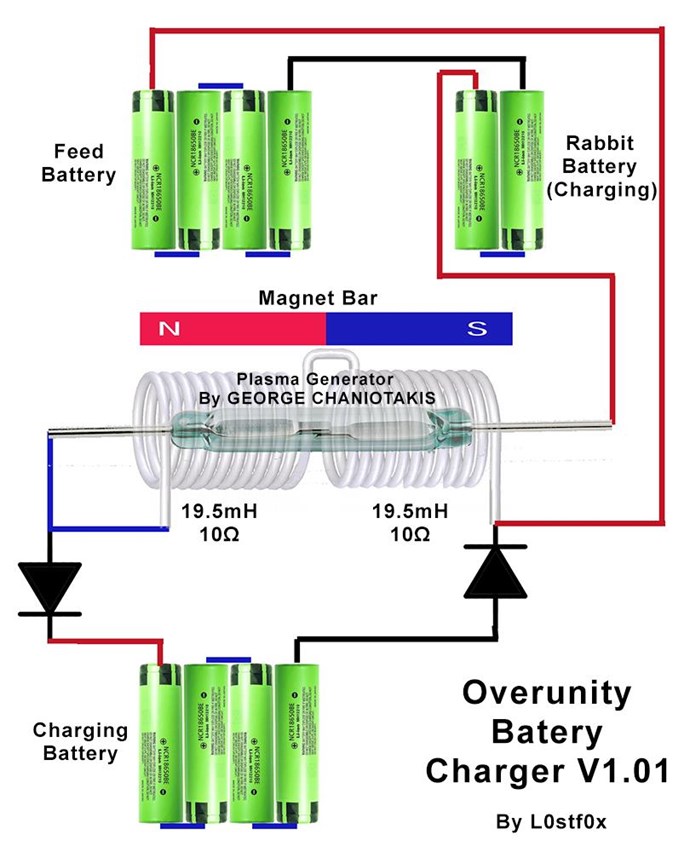
It has to be that in the video.
Also I found that circuit that looks to be important. Maybe is the one of the "Last Test" video, but I am not sure!
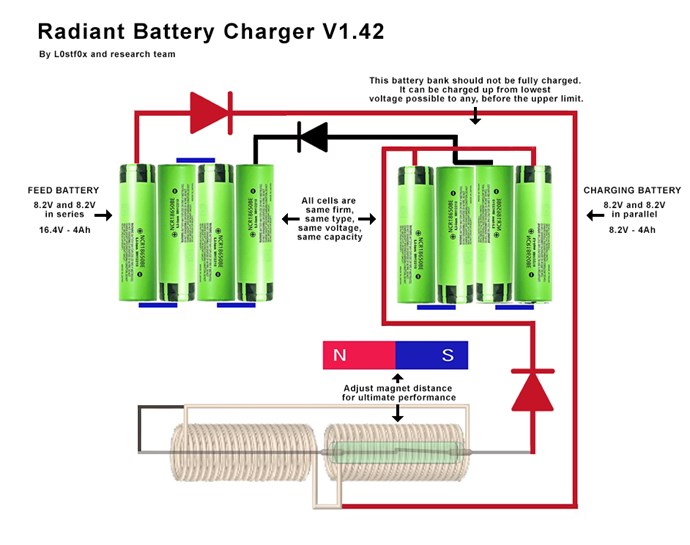
Those following are different type but also succesfull...
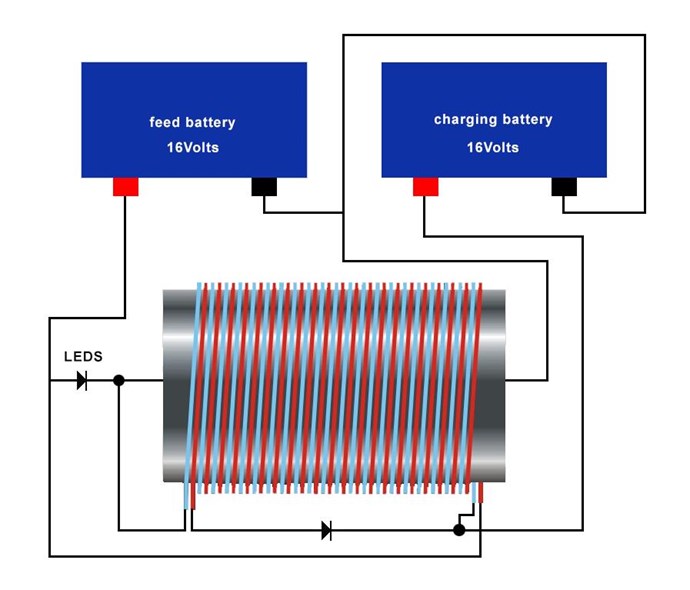
this is dual coil not a POC. Reed is not visible.. Its in the middle of the coils.
This 1 battery charger also worked as I remember. Reed is not visible.. Its in the middle of the coils.
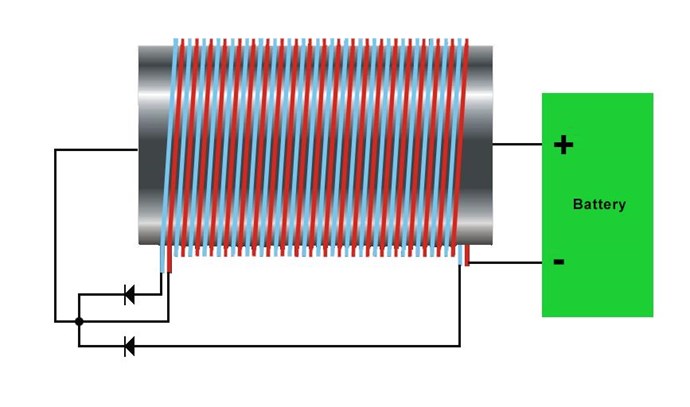
laters ![]()



OK the drawing is poor and many parts are without values, we will get to those later on.. If you want to ask anything just do. I will be happy to help.
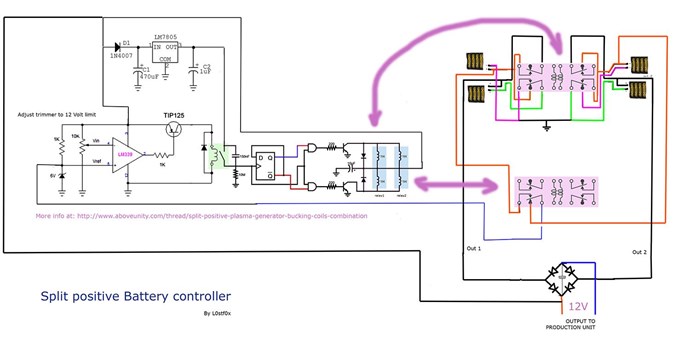
PART 1: The batteries and controller
---------------------------------------
For a 12V split positive system, you will need four sets of four cells li-ion 4,2V in series... 4 x 16V sets (new batteries)
16 Batteries in total. These batteries are very good strong and cheap.. I got the same.. fully charged go to 4.22V and the 3400mah is not far from reality, but I would say 3200mah.
https://www.aliexpress.com/item/32819895203.html?spm=a2g0s.9042311.0.0.27424c4dBqu4as
Get 4 battery holders with four cells each. This type is perfect..
https://www.aliexpress.com/item/33028134003.html?spm=a2g0o.productlist.0.0.112b430bHvdHJ7&algo_pvid=fc1174f0-55ac-4923-908b-d24f1a3eb2ab&algo_expid=fc1174f0-55ac-4923-908b-d24f1a3eb2ab-8&btsid=f12ad714-613d-43bd-8c13-51ba3c54484a&ws_ab_test=searchweb0_0,searchweb201602_8,searchweb201603_52
We use 16 volts to get 12 volts without stressing the batteries to be fully charged.. they will be around 75% charged when the controller will change them. The controller monitors only the "active" charging batteries, not the difference and not the discharging side. That is why is important to use same batteries, to have a balanced and linear charge-discharge action.
We need two Dual coil latching relays with 4 switching lines each. I know they are rare expensive and difficult to find.
I used to use this type of power relay
youtube.com watch?v=6zzCSkp6BSE ... you can stick the 2 relays back to back with the magnet at the middle,
but you will need a slight more complicated driver due to their single coils.
Lately I got some dual coil relays. And they work fine for medium current applications.
Remember the more current switching they can withstand the better.
Those are ok I guess to start with..
DS4E-ML2-DC12V 12V 12VDC 2A Dual Coil Relays
https://www.aliexpress.com/item/32843785191.html?spm=a2g0s.9042311.0.0.27424c4daBMusC
Remember: The circuit I showed is for dual coil latching relays only.
Here is at the simulation to test it..
http://tinyurl.com/yy8o8j63
Why we use latching relays? for the obvious reason. To save wasted energy at the coils during the charging/discharging process.
The periods of the switching time varies. Because every batery type has a natural speed of moving current between 2 specific batteries,
but also the load-resistance will change some of the speed as well.
It is fast at the beginning and slow at the end. This is normal.
But it will be minutes not seconds. We will discuss this part later..
So by using latching relays to switch the batteries, is done with just one pulse.
So The lower consumption controller the better.
This controller is energized by the potential difference (split positive output), and will consume almost nothing.
The switching pins of the first relay goes to batteries and the other relay pins are used for changing the monitored voltage of the comparator.
There are more pins left free at the second relay to do more things.. like sending energy back to feeding side, etc we ll talk about it later..
You can skip the part 1 if you loop energy back to feeding side. So no battery switching is necessary. this is successfully done in the "Last Test" video.
PART 2: The OUTPUT
--------------------------------
The split positive potential difference, goes to a simple bridge rectifier so we can have stable terminals + and -.
From there we need to connect the productive part.
Lets see what we already know about split positive's output.
If we imagine a regular four battery system with zero resistance on wires and zero resistance on the charging battery
we get 100% of the energy back. Let us now place a resistor between the positives. The current will delay at the resistor,
this delay will cost us energy, transformed in heat at resistor.
The batteries will try to obey to natural speed of the potential difference pressure, obstacles like the resistor or transformer
or motor need to be as much as compatible to this speed, so this will limit the heat losses.
It is obvious that this system is not suitable to power your household rather to prove the overunity.
It will rather be good to be used as power bank for mobiles etc. Except if you spend a lot of money in batteries and high power circuitry.
So if you ask me what is the most productive unit to connect to such potential difference,
the answer is the plasma generator combined with a nice transformer which its secondary will have a nice POC arrangement.
BUT ... If you want to use motor/dynamo coupling setup, then you will definitely have more losses. But it will still be overunity.
This has to be done using as motor, a pancake motor with wide rotor and strong magnets (which mean low consumption and high torque)
to drive a dynamo with thin rotor (thin-long rotor OR planetary gearbox and thin-short dynamo),
For example this dynamo I have worked on lately (not ready yet), is a thin rotor long stator,
low rpm type, dynamo.
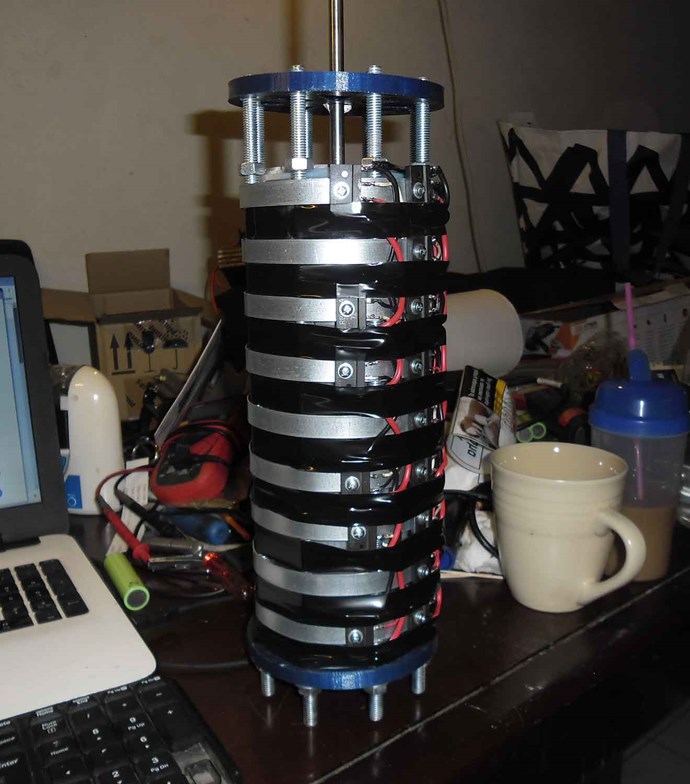
Plasma generator has advantages and disadvantages,
It is good for fast converting DC to AC and drive a transformer without any circuitry and extra parts losses.
It is good for limiting its heat losses by correcting the magnet distance.
The bad thing is that is almost impossible to get it to a stable frequency. It also has limited life even with suitable usage.
Other problems are: it will not start oscillating some times, especially if you left it in the best position from the last test.
You need to move it forward to the magnet to start the oscillation, and then slowly drag it away to accomplish best performance.
So it is a pain in the @ss I would say. But its good to experience with it.
Instead of reed switch setup, you can use any low consumption (few electronic parts) oscillator to drive the POC transformer.
You have to choose what you want to use. So the basic split positive system is described in general lines.
I will be here to discuss anything about it.
Remember: The production unit will just use the passage of current to make something free for you and then it will give it back to source.
Heat/sound/vibrations losses are the only enemy.
Laters ![]()
The same circuit but with feed back to the charging battery..
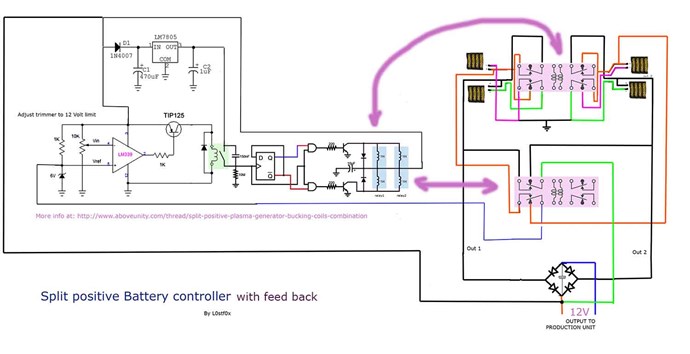
https://ibb.co/DMzJFqc
i really hope you know more than i do, because its a beautiful build job ! but
i always thought these split positive circuits required the use of large lead acid betteries, -
because the free energy came from the *spike desulfation* charging, - basically using HV too cheat the system and gain over-unity by using chemistry for discharging the batteries, and hitting the cells with an "electricity hammer" too charge them
Hello Patrick, I know what you mean.. That is the common way ![]() Most of my tests was that way
Most of my tests was that way ![]()
But I believe it can be easier without using high voltage spikes.
I will agree with you, most of the split positive setups use lead acid Batteries.
I have never used any lead acid Batteries with split positive. All my experiments are done with Li-Ion batteries without any problems, off course during setup testings I have destroy many of them. But I want to believe that I have learned something ![]()
The system I propose here is not relying to HV spikes, I really don't think that its the best way. The free energy here clearly comes only from "gently" using the passing current from one battery to other. That is the main idea of split positive technique, the energy to be transferred to another storage because if we direct it to the same storage, the energy will be transformed to something different that the battery cannot handle it and losing it. Its the Batteries and the Capacitors design!... Its this disability to accept the energy back to them and re-store it. In reality they transform their own energy to an unrecognized type for them.
Passing it through the positives of 2 batts is a very very clever trick to pass the energy to the other storage and swap the last with the other to keep the going current speed as stable as you can.. And that is working fine!!
The important if not the most important part of this system is the production unit that you will connect there. The POC coils are one good example... They can work with the minimum of losses, and are far productive by any other coil arrangement known by me and I have tried countless coil setups.
I will build a complete split positive system when I find the time.. Unfortunately I work on another project right now and I don't have the time to build it. ![]()
Hi all
For those who are looking for a way to replicate an interesting experiment within the reach of all
this thread is a perfect example.
They experiment on splitting positive.
Very nice work wistiti and lostfox
Edwin Gay is the only one who succeeded with this principle, Bédini and Linderman discussed it at length. I believe that this principle is fundamental to the success of an aboveunity system
Jagau


In physics, scalars are physical quantities that are unaffected by changes to a vector space basis. Scalars are often accompanied by units of measurement, as in "10 cm". Examples of scalar quantities are mass, distance, charge, volume, time, speed, and the magnitude of physical vectors in general.
You need to forget the Non-Sense that some spout with out knowing the actual Definition of the word Scalar! Some people talk absolute Bull Sh*t!
The pressure P in the formula P = pgh, pgh is a scalar that tells you the amount of this squashing force per unit area in a fluid.
A Scalar, having both direction and magnitude, can be anything! The Magnetic Field, a Charge moving, yet some Numb Nuts think it means Magic Science!
Hello my children. This is Yahweh, the one true Lord. You have found creation's secret. Now share it peacefully with the world.
Ref: Message from God written inside the Human Genome
God be in my head, and in my thinking.
God be in my eyes, and in my looking.
God be in my mouth, and in my speaking.
Oh, God be in my heart, and in my understanding.
We love and trust in our Lord, Jesus Christ of Nazareth!

More than anything else, your contributions to this forum are most important! We are trying to actively get all visitors involved, but we do only have a few main contributors, which are very much appreciated! If you would like to see more pages with more detailed experiments and answers, perhaps a contribution of another type maybe possible:
They REFUSE to tell me why!
The content I am sharing is not only unique, but is changing the world as we know it! Please Support Us!
Thank You So Much!
 Chris
360
Chris
360

Ere many generations pass, our machinery will be driven by a power obtainable at any point of the universe. This idea is not novel. Men have been led to it long ago by instinct or reason. It has been expressed in many ways, and in many places, in the history of old and new. We find it in the delightful myth of Antheus, who drives power from the earth; we find it among the subtle speculations of one of your splendid mathematicians, and in many hints and statements of thinkers of the present time. Throughout space there is energy. Is this energy static or kinetic? If static, our hopes are in vain; if kinetic - and this we know it is for certain - then it is a mere question of time when men will succeed in attaching their machinery to the very wheelwork of nature.
Experiments With Alternate Currents Of High Potential And High Frequency (February 1892).